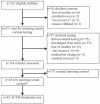Prevalence of hypothalamic-pituitary-adrenal axis suppression in children treated for asthma with inhaled corticosteroid
- PMID: 23633903
- PMCID: PMC3381924
- DOI: 10.1093/pch/17.5.e34
Prevalence of hypothalamic-pituitary-adrenal axis suppression in children treated for asthma with inhaled corticosteroid
Abstract
Objective: To determine the prevalence of hypothalamic-pituitary-adrenal (HPA) axis suppression in asthmatic children on inhaled corticosteroids (ICS).
Methods: Clinical and demographic variables were recorded on preconstructed, standardized forms. HPA axis suppression was measured by morning serum cortisol levels and confirmed by low-dose adrenocorticotropic hormone stimulation testing.
Results: In total, 214 children participated. Twenty children (9.3%, 95% CI 5.3% to 13.4%) had HPA axis suppression. Odds of HPA axis suppression increased with ICS dose (OR 1.005, 95% CI 1.003 to 1.009, P<0.001). All children with HPA axis suppression were on a medium or lower dose of ICS for their age (200 μg/day to 500 μg/day). HPA axis suppression was not predicted by drug type, dose duration, concomitant use of long-acting beta-agonist or nasal steroid, or clinical features.
Conclusion: Laboratory evidence of HPA axis suppression exists in children taking ICS for asthma. Children should be regularly screened for the presence of HPA axis suppression when treated with high-dose ICS (>500 μg/day). Consideration should be given to screening children on medium-dose ICS.
Objectif: Déterminer la prévalence de suppression de l’axe hypothalamo-hypophyso-surrénalien (HHA) chez les enfants asthmatiques traités au moyen de corticoïdes par aérosol (CPA).
Méthodologie: Les chercheurs ont obtenu des variables cliniques et démographiques à l’aide de formulaires standardisés préétablis. Ils ont mesuré la suppression de l’axe HHA au moyen de taux de cortisol sérique le matin et l’ont confirmée grâce à un test de stimulation à l’hormone adrénocorticotrope (ACTH) à faible dose.
Résultats: Sur les 214 enfants qui ont participé à l’étude, 20 (9,3 %, 95 % IC 5,3 % à 13,4 %) présentaient une suppression de l’axe HHA. Le risque d’une telle suppression augmentait proportionnellement à la dose de CPA (RRR 1,005, 95 % IC 1,003 à 1,009, P<0,001). Tous les enfants présentant une suppression de l’axe HHA prenaient une dose moyenne à faible de CPA compte tenu de leur âge (200 μg/jour à 500 μg/jour). La suppression de l’axe HHA ne pouvait être prédite selon les caractéristiques cliniques, le type de médicament, la durée de la dose ou l’utilisation concomitante de bêta-agonistes à longue durée d’action ou de stéroïdes par voie nasale.
Conclusion: Il existe des preuves de laboratoire de suppression de l’axe HHA chez les enfants qui prenaient des CPA pour traiter leur asthme. Il faudrait procéder au dépistage régulier de la suppression de l’axe HHA chez des enfants traités au moyen de fortes doses de CPA (plus de 500 μg/jour). Il faut également envisager de dépister les enfants traités au moyen d’une dose moyenne de CPA.
Keywords: Asthma; Hypothalamic-pituitary-adrenal axis; Inhaled corticosteroid.
Figures
Similar articles
-
Evidence of hypothalamic-pituitary-adrenal axis suppression during moderate-to-high-dose inhaled corticosteroid use.Eur J Pediatr. 2015 Nov;174(11):1421-31. doi: 10.1007/s00431-015-2610-9. Epub 2015 Aug 9. Eur J Pediatr. 2015. PMID: 26255048
-
Effect of Long-term Inhaled Corticosteroids on the Hypothalamic-Pituitary-Adrenal Axis in Children with Asthma.Indian J Pediatr. 2024 May;91(5):441-447. doi: 10.1007/s12098-023-04706-6. Epub 2023 Jul 7. Indian J Pediatr. 2024. PMID: 37418102
-
Hypothalamic-pituitary-adrenal axis suppression in asthmatic children on inhaled and nasal corticosteroids: is the early-morning serum adrenocorticotropic hormone (ACTH) a useful screening test?Pediatr Allergy Immunol. 2011 Sep;22(6):614-20. doi: 10.1111/j.1399-3038.2011.01161.x. Epub 2011 Jul 28. Pediatr Allergy Immunol. 2011. PMID: 21797928
-
Hypothalamic-pituitary-adrenal axis suppression and inhaled corticosteroid therapy. 2. Review of the literature.Neuroimmunomodulation. 1998 Nov-Dec;5(6):288-308. doi: 10.1159/000026349. Neuroimmunomodulation. 1998. PMID: 9762011 Review.
-
Intranasal corticosteroids and adrenal suppression.Neuroimmunomodulation. 2009;16(5):353-62. doi: 10.1159/000216193. Epub 2009 Jun 29. Neuroimmunomodulation. 2009. PMID: 19571596 Review.
Cited by
-
The use of inhaled corticosteroids in pediatric asthma: update.World Allergy Organ J. 2016 Aug 12;9:26. doi: 10.1186/s40413-016-0117-0. eCollection 2016. World Allergy Organ J. 2016. PMID: 27551328 Free PMC article. Review.
-
CSACI position statement: systemic effect of inhaled corticosteroids on adrenal suppression in the management of pediatric asthma.Allergy Asthma Clin Immunol. 2015 Mar 14;11(1):9. doi: 10.1186/s13223-015-0075-z. eCollection 2015. Allergy Asthma Clin Immunol. 2015. PMID: 25802532 Free PMC article.
-
Adrenal suppression from exogenous glucocorticoids: Recognizing risk factors and preventing morbidity.Paediatr Child Health. 2021 Jun 11;26(4):242-254. doi: 10.1093/pch/pxab015. eCollection 2021 Jul. Paediatr Child Health. 2021. PMID: 34630779 Free PMC article. Review.
-
Adrenal suppression in patients taking inhaled glucocorticoids is highly prevalent and management can be guided by morning cortisol.Eur J Endocrinol. 2015 Nov;173(5):633-42. doi: 10.1530/EJE-15-0608. Epub 2015 Aug 20. Eur J Endocrinol. 2015. PMID: 26294794 Free PMC article.
-
Case 1: A premature infant with apneic spells.Paediatr Child Health. 2013 Nov;18(9):497-8. Paediatr Child Health. 2013. PMID: 24426810 Free PMC article. No abstract available.
References
-
- Global strategy for asthma management and prevention, global initiative for asthma (GINA) 2008. < www.ginasthma.org/guidelines-gina-report-global-strategy-for-asthma.html> (Accessed November 5, 2011). - PubMed
-
- Bethesda MNH, Lung, and Blood Institute . Program: Expert panel report III: Guidelines for the diagnosis and management of asthma 2007. < www.ncbi.nlm.nih.gov/books/NBK7232/> (Accessed November 5, 2011).
-
- Barnes PJ, Pedersen S, Busse WW. Efficacy and safety of inhaled corticosteroids. New developments. Am J Respir Crit Care Med. 1998;157(3 Pt 2):S1–53. - PubMed
LinkOut - more resources
Full Text Sources

